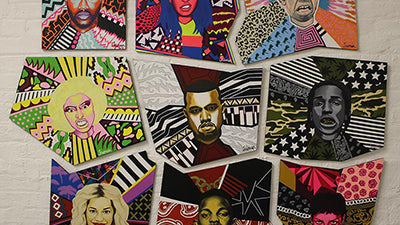
Tell us about yourself?
I’m Jasmin Kaur Sehra. I’m an artist residing from London. I’ve always been surrounded by the arts growing up as I come from a family of musicians and artists, so pursuing the arts is something that occurred naturally. My parents would always buy us collaging materials, colour books, colour pencils, stickers- the works! I remember having a white “colour box” – that’s what we used to call it. It was packed full of different pencils and pens. We always used to have posters on the wall, which I used to bombard with stickers of butterflies. I loved the colours and patterns. One collage I specifically remember was of a palm tree on an island. It’s funny that palm trees now have become one my favourite things to paint. I absolutely love them. Buying art materials was always a joy. If I wasn’t collaging or drawing I was playing the violin but I then fell out of this after five years of practice primarily because of studies. But the visual arts were always something I didn’t let go of. My Dad used to draw and even to this day I love to look back at his work, just to see the contrast between my work and his. I even have a few pieces in a folder from when I was younger, including the palm tree collage, preserving my memories and work.
Describe your style of art?
I focus a lot on portraiture, pattern and colour in my artwork. In the past I worked a lot on fine art including detailed graphite drawings. But this all changed when I was going through some of my parents old photographs from the late 80’s/ early 90’s. The photographs became the catalyst that changed my focus. The bright, bold graphics, patterns and colours really opened up a part of my imagination that I hadn’t fully explored. I distinctly remember this happening during my degree.
How did you first get into your art?
I’ve always been creative since I was very young. It’s something that has always just been present!

At what point did you realise you may excel in this?
Throughout school I constantly chose Art as a subject I wanted to study. It was definitely my main focus and passion since I was young. It was an organic path.
Considering the stereotype of some Asian parents, what do your family think about what you do?
We all support each other, which is a beautiful blessing. My Dad plays a huge part in the creation of my work as he cuts the wood I paint on. He works with carpentry, which is also something that my Granddad worked with too. Also throughout the years my brother has really supported me in what I do through teaching me some valuable skills that I use in my work today. Shout out to my Dad and brother!
How does inspiration find you for your art?
I absolutely love looking back at old photographs, hearing stories about Kenya and history in general, including images and stories about Sikhi. Looking through my microscope, natural form and all things that exude eternal value, have a massive influence within my pattern work.
I can take something that is so seemingly mundane and dissect it right down to the smallest detail. My sketchbooks contain work that I deem to be sacred; literally very few people have seen them. If you’re lucky enough to see one, I’ve opened up my heart and soul to you. A lot of the time with my pattern work I have visions in my mind, I guess it’s the blend of all my inspirations having a play with the mind’s chemicals. I really just love for my art to flow naturally; wherever my heart directs me, it seems the best way.
Have you gone through a period when inspiration has been hard to come by, and if so, how did you get over it?
Definitely, it happens to everyone. Listening to music is a healer. I also like to look back at old work and my inspirations. My sketchbooks are part of my personal visual library; it’s always a great place to find something that might bind a few loose cells in the mind. Ultimately, you just have to let nature take its course.

Take us through your creative process?
Once an idea comes to me it’s etched into my mind. Then I just create. I source the wood with my Dad, which he then cuts. And once primed I quickly sketch the piece and paint the patterns freehand. The length of time it takes really depends on the piece; on average I would say it could take me from a week to three weeks.
I always paint in a place I feel most comfortable and at ease, anywhere where I can be on my own. I prefer to be secluded when I create, so most of the time I’ll be up until the early hours, when everything is so serene, it just creates a good earthly vibe.
Who are your artistic inspirations?
Besides the inspirations I’ve mentioned the first I would have to say are the tribesmen. The Maasai tribe for example, for their beadwork, body paint rituals and the Ndebele people for their hut patterns. I think the beauty of tribe people is that their work embodies “organic”, it’s honest, it holds a story, they are rituals from the past- they carry the souls of the people. I also get a lot of inspiration from music artists, how they are visually through their music videos, lyrics and album artwork. I think that’s where my family’s musical influence comes to play; instead of creating music, music helps me to create.

How do you find showcasing your creation?
I’m always showing the people closest to me for feedback on my work, my family, best friends or cousins, just making sure I have their ok before anything else. I think initially when I first started showcasing my work through exhibitions and on social networking sites, I was always nervous as to what the reception of my work would be like. But over the years I have grown to be more confident of my work. I think the nervousness will always be there, it’s just something I’ve learnt to deal with overtime.
Tell us about a particularly popular creation and why you feel it was so appreciated.
I think I’ve been evolving so much with my work over the past few years that each piece or series has had their fair share in the spotlight. I feel my graphite drawings were appreciated because of the hyperrealism each piece detained. For someone to use a pencil to obtain life like results you can see in an SLR photograph is something that I guess is not of the norm. My illustrated zombie series also received great praise, this is something that designers at MTV recognized, and a commissioned piece is now on the wall in their London headquarters. My recent portraiture and pattern work has allowed me to reach music artists through social media and in person. It’s all a blessing.

What would you consider your biggest achievement as an artist thus far?
Honestly, it’s finding a visual style and using mediums I’m comfortable in using. I found it quite difficult to maintain a focus and I love experimenting and using different mediums. But I’m now focusing on pattern work and paintings rather than digital work. I just love the freedom you get with using brushes and paints rather than a mouse and a computer screen. But every now and then I’ll revisit the digital world.
Also most recently I travelled to California where I was able to exhibit my work, it really was a dream come true thanks to my Cali family!
How do you look to improve as artist?
I can only let things flow naturally. Everything is a process, using the opportunities I’m given and by seeking my own, I believe that’s what truly determines how I progress. I’m always learning.

Do you have anyone you would particular love to work with?
Collaborating with tribe people because their work has provided me with the fuel for my artwork. Just the idea of using old and new I think would be amazing; people with very different ways of life uniting to make one immense piece.
What do you do to relax?
I just love spending time with the ones I love most. It just keeps you grounded. A lot of the time my siblings, best friend and I will just get together and produce rhymes against instrumentals. It’s a lot fun and we spend a lot of time laughing, I guess another creative outlet.

Tell us about the relationship between your Sikhi/Punjabi background and your art?
I think just knowing that in Sikhi you have visual arts and music through paintings and Shabads provides you with that foundation that you are now someone in the present day who is going to carry this formation for years to come. Obviously the art is different, but you’re using the basis to form your own legacy.
In an ideal world, where would you like your art to take you in life?
Ideally, anywhere! I’m just going with the flow, hopefully, within the future, through my own brand of products, I'd really like to go back to California and to the places that truly inspire me.

If you could showcase your work anywhere in the world, where would you do it and why?
I want to share my work all over the world. But it would be my dream to showcase my work within a tribe community in Africa. The mix of old and new would be interesting. Just being able to showcase my work in a country that my family has resided from, a place that has provided me with inspiration would be an honour.
If you could live anywhere in the world, where would you live?
Anywhere near the sea, palm trees and tropical flowers.



1 comment
Jasmin Kaur Sehra I congratulate on your great Art Work and on going journey in the World of Art and reach your goals with Waheguru Ji’s Blessings and mine always. Keep aiming high.
Gurfateh ♡